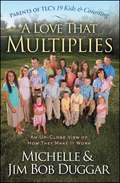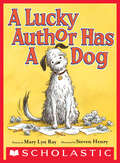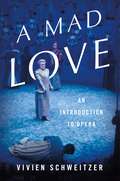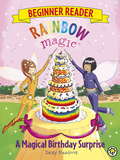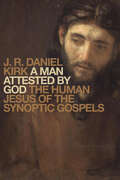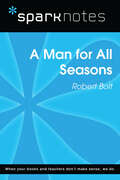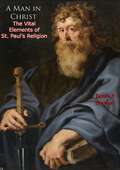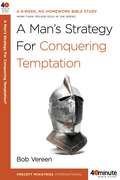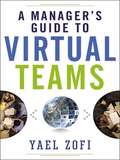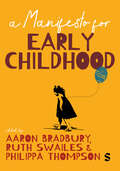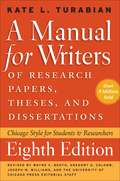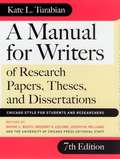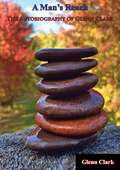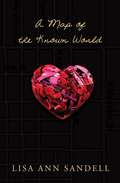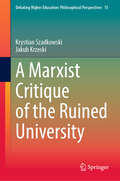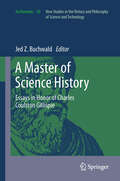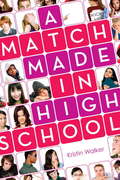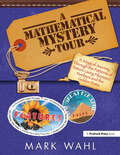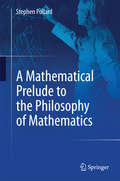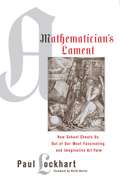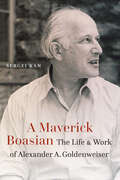- Table View
- List View
A Love That Multiplies: An Up-Close View of How They Make it Work
by Jim Bob Duggar Michelle DuggarNow in paperback--Michelle and Jim Bob Duggar share the joys and challenges of parenting with faith. Anyone who sees America's best-known mega family on television is filled with curiosity. People want to know....Why do they have so many children? What do they believe? What does the family do for fun? How do they get their children to obey so well? How can they afford to live? Now, Michelle and Jim Bob show how parents can succeed whether they're rearing a single child or several.In this second book from the Duggars, they explain the principles that equip their family to face life's realities--including their most recent hardship with the three-month premature birth of their newest child, Josie. Josie's birth tested everything the family believed in and demonstrates how they worked together, relying on their faith. They also discuss helping their older children navigate decisions about courtship and marriage and how to prepare to be productive adults. As the Duggars share their hearts and faith, readers will find answers to their many questions about this inspirational family.
A Lucky Author Has a Dog
by Mary Lyn RayFor every aspiring young author out there, this story of a lucky author (and, of course, her dog!) offers both answers and inspiration!Ever wonder what it's like to be an author?Does she write in a quiet corner somewhere? Or someplace loud and busy? Does she have ideas forty times a day? Or does she sometimes get stuck? And how does her dog make her lucky?New York Times bestselling author Mary Lyn Ray, together with illustrations from Steven Henry (Ella the Elegant Elephant) that are chock full of hidden jokes, answers these questions and more in a story of one writer, her furry friend, and a school visit that brings authors young and old (and dogs!) together.
A Mad Love: An Introduction to Opera
by Vivien SchweitzerA lively introduction to opera, from the Renaissance to the twenty-first centuryThere are few art forms as visceral and emotional as opera-and few that are as daunting for newcomers. A Mad Love offers a spirited and indispensable tour of opera's eclectic past and present, beginning with Monteverdi's L'Orfeo in 1607, generally considered the first successful opera, through classics like Carmen and La Boheme, and spanning to Brokeback Mountain and The Death of Klinghoffer in recent years. Musician and critic Vivien Schweitzer acquaints readers with the genre's most important composers and some of its most influential performers, recounts its long-standing debates, and explains its essential terminology. Today, opera is everywhere, from the historic houses of major opera companies to movie theaters and public parks to offbeat performance spaces and our earbuds. A Mad Love is an essential book for anyone who wants to appreciate this living, evolving art form in all its richness.
A Magical Birthday Surprise: Book 3 (Rainbow Magic Beginner Reader #3)
by Daisy MeadowsLearning to read is fun with the Rainbow Magic Fairies! Developed in conjunction with Early Years reading consultants and based on the most up-to-date educational research, the Rainbow Magic Beginner Readers are the perfect way to introduce your child to the magical world of reading.
A Malaysian Ecocriticism Reader: Considerations of Nature, Culture, Place and Identities
by Agnes S. K. Yeow Wai Liang ThamThis collection of essays brings together ecocritical interpretations of Malaysian texts – including fiction, nonfiction, and other media / cultural expressions. It includes original works by environmental activists as well as emerging and established scholars, who collectively analyse various aspects of Malaysian ecological discourse.The contributors address crucial – and often controversial – topics such as local ecological imaginations, wildlife conservation, overdevelopment, postcolonial ecological identities, biopolitics, nature and sexuality, nature and race, the commodification of nature, nature–culture embodiments and entanglements, human–animal relations, waste and materiality, human and other-than-human agency, toxicity and slow violence, self-representations as well as attitudes towards land, nativity and indigeneity, migrancy and diaspora.Readers will gain valuable insights into the ways in which environments and ecological relationships are mediated within this national space, while opening up room to theorise beyond its boundaries.
A Man Attested by God: The Human Jesus of the Synoptic Gospels
by J. R. KirkThought-provoking alternative perspective on the full humanity of Jesus Christ In A Man Attested by God J. R. Daniel Kirk presents a comprehensive defense of the thesis that the Synoptic Gospels present Jesus not as divine but as an idealized human figure. Counterbalancing the recent trend toward early high Christology in such scholars as Richard Bauckham, Simon Gathercole, and Richard Hays, Kirk here thoroughly unpacks the humanity of Jesus as understood by Gospel writers whose language is rooted in the religious and literary context of early Judaism. Without dismissing divine Christologies out of hand, Kirk argues that idealized human Christology is the best way to read the Synoptic Gospels, and he explores Jesus as exorcist and miracle worker within the framework of his humanity. With wide-ranging exegetical and theological insight that sheds startling new light on familiar Gospel texts, A Man Attested by God offers up-to-date, provocative scholarship that will have to be reckoned with.
A Man for All Seasons (SparkNotes Literature Guide Series)
by SparkNotesA Man for All Seasons (SparkNotes Literature Guide) by Robert Bolt Making the reading experience fun! Created by Harvard students for students everywhere, SparkNotes is a new breed of study guide: smarter, better, faster. Geared to what today's students need to know, SparkNotes provides: *Chapter-by-chapter analysis *Explanations of key themes, motifs, and symbols *A review quiz and essay topicsLively and accessible, these guides are perfect for late-night studying and writing papers
A Man in Christ: The Vital Elements Of St. Paul's Religion
by James S StewartDive deep into the transformative teachings of one of Christianity's most influential figures with James S. Stewart's profound work, "A Man in Christ: The Vital Elements of St. Paul's Religion." This insightful and scholarly book offers a comprehensive exploration of the Apostle Paul's spiritual journey, his theological insights, and the enduring impact of his teachings on the Christian faith.James S. Stewart, a distinguished theologian and preacher, meticulously examines the key elements of St. Paul's religion, providing readers with a clear understanding of his profound spiritual convictions and their practical implications. Stewart's eloquent writing brings to life Paul's experiences, from his dramatic conversion on the road to Damascus to his tireless missionary work and his deep theological reflections."A Man in Christ" delves into the core themes of Paul's letters, including justification by faith, the transformative power of grace, the nature of the Church, and the hope of eternal life. Stewart expertly unpacks these concepts, showing how they form a cohesive and compelling vision of Christian life centered on a personal relationship with Jesus Christ.Through careful analysis and thoughtful interpretation, Stewart highlights the relevance of Paul's teachings for contemporary readers, emphasizing the timeless truths that continue to inspire and challenge believers today. His work bridges the historical and cultural gap between the first century and the modern world, making Paul's message accessible and meaningful for all.This book is an essential read for theologians, pastors, students of biblical studies, and anyone seeking a deeper understanding of the foundations of Christian faith. James S. Stewart's "A Man in Christ" is not only a scholarly achievement but also a source of spiritual enrichment, inviting readers to experience the vitality and depth of St. Paul's religion.
A Man's Strategy for Conquering Temptation (40-Minute Bible Studies)
by Bob VereenChristian men are in the midst of a life-long process. They’re being transformed by the renewing of their minds, and through the power of the Holy Spirit, they’re crucifying the sinful nature with its passions and desires. But the world, the flesh, and the devil go to great lengths to thwart the process. Our culture is obsessed with sex. Pornography, declining morals, pervasive visual stimulation, rampant divorce, and epidemic adultery. They all reflect ungodly passions. And inflame impure thoughts. In this six-week study you’ll learn that God has provided everything you need to resist temptation. Through the examples of men in Scripture–those who fell into sin and those who stood firm–you’ll find hope for controlling your passions. You’ll learn how to choose the path of purity. And you’ll find assurance that through the power of the Holy Spirit and God’s Word, you can escape the corruption of this world and one day stand before God blameless and pure. From the Trade Paperback edition.
A Manager's Guide to Virtual Teams
by Yael ZofiYael Zofi&’s proprietary Trust Wheel model is a proven solution to the unique challenges managers must overcome as more people migrate to partially or fully-remote working situations.Based on the author&’s twenty-plus years of consulting experience, this powerful tool encourages cohesiveness and engagement among team members--even if they&’ve never met. A Manager&’s Guide to Virtual Teams does this by providing a practical road map for bridging the physical distance among coworkers, incorporating self-study exercises and simple, fun activities that develop trust and ensure your team&’s success.The book explores the most critical elements to success for a team founded in trust, including:accountability,communication,conflict management,and deliverables.Complete with examples, case scenarios, and strategies to help you navigate even your biggest hurdles, A Manager&’s Guide to Virtual Teams will help your disparate collection of people get their work &“out the door&” faster and better.
A Manifesto for Early Childhood
by Aaron Bradbury Ruth Swailes Philippa ThompsonThe Early Childhood Sector faces many challenges today. Sector-wide pressures and policy changes mean settings are struggling with many issues including funding, retention and recruitment of staff. As change looms, this new book takes the opportunity to explore what could be possible. It draws together expertise and experience from across many sectors, including education, health, and social work to explore what Early Childhood provision could look like, if we got it right. What do Early Childhood experts recommend? What is genuine, unconstrained good practice? What do we want for our children, families, and colleagues in the sector? This hopeful book looks forwards to what could be possible. It is A Manifesto for Early Childhood.
A Manifesto for Early Childhood
by Aaron Bradbury Ruth Swailes Philippa ThompsonThe Early Childhood Sector faces many challenges today. Sector-wide pressures and policy changes mean settings are struggling with many issues including funding, retention and recruitment of staff. As change looms, this new book takes the opportunity to explore what could be possible. It draws together expertise and experience from across many sectors, including education, health, and social work to explore what Early Childhood provision could look like, if we got it right. What do Early Childhood experts recommend? What is genuine, unconstrained good practice? What do we want for our children, families, and colleagues in the sector? This hopeful book looks forwards to what could be possible. It is A Manifesto for Early Childhood.
A Manual for Writers of Research Papers, Theses, and Dissertations
by Kate L. TurabianA little more than seventy-five years ago, Kate L. Turabian drafted a set of guidelines to help students understand how to write, cite, and formally submit research writing. Seven editions and more than nine million copies later, the name Turabian has become synonymous with best practices in research writing and style. Her Manual for Writers continues to be the gold standard for generations of college and graduate students in virtually all academic disciplines. Now in its eighth edition, A Manual for Writers of Research Papers, Theses, and Dissertations has been fully revised to meet the needs of today’s writers and researchers. The Manual retains its familiar three-part structure, beginning with an overview of the steps in the research and writing process, including formulating questions, reading critically, building arguments, and revising drafts. Part II provides an overview of citation practices with detailed information on the two main scholarly citation styles (notes-bibliography and author-date), an array of source types with contemporary examples, and detailed guidance on citing online resources. The final section treats all matters of editorial style, with advice on punctuation, capitalization, spelling, abbreviations, table formatting, and the use of quotations. Style and citation recommendations have been revised throughout to reflect the sixteenth edition of The Chicago Manual of Style. With an appendix on paper format and submission that has been vetted by dissertation officials from across the country and a bibliography with the most up-to-date listing of critical resources available, A Manual for Writers remains the essential resource for students and their teachers.
A Manual for Writers of Research Papers, Theses, and Dissertations 8th Edition
by Kate L. TurabianA little more than seventy-five years ago, Kate L. Turabian drafted a set of guidelines to help students understand how to write, cite, and formally submit research writing. Seven editions and more than nine million copies later, the name Turabian has become synonymous with best practices in research writing and style. Her Manual for Writers continues to be the gold standard for generations of college and graduate students in virtually all academic disciplines. Now in its eighth edition, A Manual for Writers of Research Papers, Theses, and Dissertations has been fully revised to meet the needs of today's writers and researchers. The Manual retains its familiar three-part structure, beginning with an overview of the steps in the research and writing process, including formulating questions, reading critically, building arguments, and revising drafts. Part II provides an overview of citation practices with detailed information on the two main scholarly citation styles (notes-bibliography and author-date), an array of source types with contemporary examples, and detailed guidance on citing online resources. The final section treats all matters of editorial style, with advice on punctuation, capitalization, spelling, abbreviations, table formatting, and the use of quotations. Style and citation recommendations have been revised throughout to reflect the sixteenth edition of The Chicago Manual of Style. With an appendix on paper format and submission that has been vetted by dissertation officials from across the country and a bibliography with the most up-to-date listing of critical resources available, A Manual for Writers remains the essential resource for students and their teachers.
A Manual for Writers of Research Papers, Theses, and Dissertations: Chicago Style for Students and Researchers (7th edition)
by Joseph M. Williams Kate L. Turabian Wayne C. Booth Gregory G. ColombThis seventh edition of Turabian's "Manual" is a classic reference revised for a new age. It is tailored to a new generation of writers using tools its original author could not have imagined-- while retaining the clarity and authority that generations of scholars have come to associate with the name Turabian.
A Man’s Reach: The Autobiography of Glenn Clark
by Glenn ClarkClark was a man who, without being himself a recognized "New Thought" leader, has been highly influential in introducing "New Thought" ideas and techniques into the churches. Clark was deeply religious and something of a mystic, a great believer in prayer. He first came into prominence through an article in the "Atlantic Monthly" titled "The Soul's Sincere Desire." He began to be much in demand as a speaker in the churches and in summer camps. In 1930 he organized a summer camp of his own in Koronis, Minnesota to which he gave the name "Camp Farthest Out." Here for a period, amidst pleasant surroundings, a group of congenial and serious-minded people met for a season of fellowship, relaxation, and spiritual renewal, under the direction of Dr. Clark and others of somewhat similar views. In 1942 he resigned from his position at the College to give all his time to helping others discover this integration of body, mind and spirit in God. Through a series of experiences told in his autobiography, "A Man's Reach," he had been brought to an unusual interest in prayer, and it became his major concern and emphasis. It set him to reading especially the works of the mystics and about them and their approach to God. Among the books he read was "Life Understood" by Frank Rawson, a onetime Christian Scientist who had been expelled from the church, and went on to become an influential leader of "New Thought" in England. The thing that attracted Clark to Rawson, he says, was that "he believed one's prayers could be just as scientifically infallible as the laws of physics and chemistry.".-Print ed.
A Map of the Known World
by Lisa Ann SandellCora Bradley dreams of escape. Ever since her reckless older brother, Nate, died in a car crash, Cora has felt suffocated by her small town and high school. She seeks solace in drawing beautiful maps, envisioning herself in exotic locales.
A Marxist Critique of the Ruined University (Debating Higher Education: Philosophical Perspectives #15)
by Krystian Szadkowski Jakub KrzeskiThis book revitalizes the Marxian concept of critique for research into the transformation of universities. It consists of a set of comprehensive and interconnected theoretical tools, starting from the reflection on the political ontology of higher education, through the critique of political economy of the sector to the analysis of activist struggles within the universities, and back to the ontological concept of the common – a foundation for the university alternative design. The tools offered and discussed in context throughout the book allow for a productive use in overcoming the current crisis of the university, as well as to avoid the pitfalls present in contemporary debates around it. Unlike the dominant discussions on the university in crisis, the authors argue that to grasp its nature, one has to reach more profound than the level of appearances such as marketization and commodification. Szadkowski and Krzeski offer a compelling reappraisal of critique as a mechanism to liberate intellectual work. By linking critique to how knowledge is structured and commodified, they help us transcend reductionist narratives of a crisis-ridden University. Prioritising ontological renewal, they embrace the political and the common, enriching our collective ways of knowing the world as a movement. Pivoting around academic and student protests in Poland, the book enables us to imagine spaces and times of critical hope that resist the capitalist subjugation of intellectual activity to knowledge production. Richard Hall, Professor of Education and Technology, De Montfort University, Leicester, UK In the century since Antonio Gramsci new works in the Marxist tradition have made only modest contributions to social thought: the combined result of the savage repression in the West of the dangerous revolutionary ideas, plus the collapse in the East into jacobin conspiracy and dogmatism. If a living, vibrant Marxism had been part of the twentieth century mainstream then much catastrophe would have been averted. Now the drive for capital accumulation, sovereign individualism and rampant nationalism have brought us to the brink of ecological disaster and World War III. Into the void step two emerging scholars, Krystian Szadkowski and Jakub Krzeski with an original Marxist critique of higher education and the common good. There is hope in this development, vital resources for reflection, discussion and action. Simon Marginson, Professor of Higher Education at the Universities of Bristol and Oxford, UK, Honorary Professor at Tsinghua University in China, and Joint Editor in Chief of the journal 'Higher Education'
A Master of Science History: Essays in Honor of Charles Coulston Gillispie (Archimedes #30)
by Jed Z. BuchwaldNew essays in science history ranging across the entire field and related in most instance to the works of Charles Gillispie, one of the field's founders.
A Match Made in High School
by Kristin WalkerWhen the principal announces that every senior must participate in a mandatory year-long Marriage Education program, Fiona Sheehan believes that her life can?t get any worse. Then she marries her ?husband?: jerky jock Todd, whose cheerleader girlfriend, Amanda, has had it in for Fiona since day one of second grade. Even worse? Amanda is paired with Fiona?s long-term crush, Gabe. At least Fiona is doing better than her best friend, Marcie, who is paired up with the very quiet, very mysterious Johnny Mercer. Pranks, fights, misunderstandings, and reconciliations ensue in an almost Shakespearean comedy of errors about mistaken first impressions, convoluted coupling, and hidden crushes. .
A Math-Based Writing System for Engineers: Sentence Algebra & Document Algorithms
by Brad HendersonThis book presents the generative rules for formal written communication, in an engineering context, through the lens of mathematics. Aimed at engineering students headed for careers in industry and professionals needing a “just in time” writing resource, this pragmatic text covers all that engineers need to become successful workplace writers, and leaves out all pedagogical piffle they do not. Organized into three levels of skill-specific instruction, A Math-Based Writing System for Engineers: Sentence Algebra & Document Algorithms guides readers through the process of building accurate, precise sentences to structuring efficient, effective reports. The book’s indexed design provides convenient access for both selective and comprehensive readers, and is ideal for university students; professionals seeking a thorough, “left -brained” treatment of English grammar and “go to” document structures; and ESL engineers at all levels.
A Mathematical Mystery Tour: Higher-Thinking Math Tasks (Grades 5-12)
by Mark WahlA Mathematical Mystery Tour has been used by thousands of students and has inspired adults to greater appreciation of the secret number language of nature. It is multidisciplinary, visual, and hands-on, practicing skills while also requiring deep math thinking. The activities are reproducible and each is accompanied with informational teacher pages giving answers, historical notes, teacher suggestions, and activity extensions.Let this geographically alive Mystery Tour integrate math with art, science, philosophy, history, social studies, and language arts. The use of the calculator, geometric construction, metric measurement, problem solving, formulating results, building models and making inferences is woven throughout the book.Each book purchase includes a link to a downloadable student newspaper, the Mathematical Mystery Tour Guide, coordinated with the book content. It is capable of being broken up into various assignments and handed out as print or sent whole electronically to each student. It is filled with games, riddles, dramatic historical information, crosswords, provocative questions, and additional math thought activities.
A Mathematical Prelude to the Philosophy of Mathematics
by Stephen PollardThis book is based on two premises: one cannot understand philosophy of mathematics without understanding mathematics and one cannot understand mathematics without doing mathematics. It draws readers into philosophy of mathematics by having them do mathematics. It offers 298 exercises, covering philosophically important material, presented in a philosophically informed way. The exercises give readers opportunities to recreate some mathematics that will illuminate important readings in philosophy of mathematics. Topics include primitive recursive arithmetic, Peano arithmetic, Gödel's theorems, interpretability, the hierarchy of sets, Frege arithmetic and intuitionist sentential logic. The book is intended for readers who understand basic properties of the natural and real numbers and have some background in formal logic.
A Mathematician's Lament
by Paul Lockhart Keith Devlin"One of the best critiques of current mathematics education I have ever seen."--Keith Devlin, math columnist on NPR's Morning EditionA brilliant research mathematician who has devoted his career to teaching kids reveals math to be creative and beautiful and rejects standard anxiety-producing teaching methods. Witty and accessible, Paul Lockhart's controversial approach will provoke spirited debate among educators and parents alike and it will alter the way we think about math forever.Paul Lockhart, has taught mathematics at Brown University and UC Santa Cruz. Since 2000, he has dedicated himself to K-12 level students at St. Ann's School in Brooklyn, New York.
A Maverick Boasian: The Life and Work of Alexander A. Goldenweiser (Critical Studies in the History of Anthropology)
by Sergei KanA Maverick Boasian explores the often contradictory life of Alexander Goldenweiser (1880–1940), a scholar considered by his contemporaries to be Franz Boas&’s most brilliant and most favored student. The story of his life and scholarship is complex and exciting as well as frustrating. Although Goldenweiser came to the United States from Russia as a young man, he spent the next forty years thinking of himself as a European intellectual who never felt entirely at home. A talented ethnographer, he developed excellent rapport with his Native American consultants but cut short his fieldwork due to lack of funds. An individualist and an anarchist in politics, he deeply resented having to compromise any of his ideas and freedoms for the sake of professional success. A charming man, he risked his career and family life to satisfy immediate needs and wants. A number of his books and papers on the relationship between anthropology and other social sciences helped foster an important interdisciplinary conversation that continued for decades after his death. For the first time, Sergei Kan brings together and examines all of Goldenweiser&’s published scholarly works, archival records, personal correspondences, nonacademic publications, and living memories from several of Goldenweiser&’s descendants. Goldenweiser attracted attention for his unique progressive views on such issues as race, antisemitism, immigration, education, pacifism, gender, and individual rights. His was a major voice in a chorus of progressive Boasians who applied the insights of their discipline to a variety of questions on the American public&’s mind. Many of the battles he fought are still with us today.
